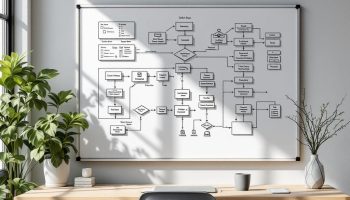
Understanding Economic Feasibility Studies
Economic feasibility studies deliver thorough financial analyses that assess project viability by evaluating potential economic returns and strategic implications across various industries. A typical economic feasibility study example, such as a solar energy project or restaurant expansion, carefully examines financial metrics, market conditions, and potential risks to determine if an initiative can deliver significant returns and align with organizational goals.
Key Takeaways
- Economic feasibility studies evaluate project viability through detailed cost-benefit analysis and financial metrics like NPV, IRR, and payback period.
- Market analysis is crucial for understanding customer base, competition, and potential market share.
- Risk identification and mitigation strategies are essential for addressing potential environmental, financial, and economic disruptions.
- Comprehensive funding and resource evaluation helps determine capital requirements and investment sources.
- Economic feasibility studies provide insights beyond immediate project scope, including job creation potential and market expansion opportunities.
“Economic feasibility studies serve as vital roadmaps, guiding organizations through the intricate landscape of project viability by balancing financial metrics, market dynamics, and risk management. Beyond mere numbers, these analyses illuminate opportunities for growth and long-term impact, paving the way for initiatives that align with both strategic goals and community potential.”
Understanding Economic Feasibility Studies
Economic feasibility studies function as comprehensive financial analyses that assess project viability and potential economic returns. You’ll find these studies essential for determining whether proposed projects or business ideas are financially sustainable and beneficial in the long term. They serve as critical decision-making tools for senior leadership during strategic planning processes, helping you make informed go/no-go decisions about resource allocation.
Financial Viability Assessment
At the core of an economic feasibility study example is the cost-benefit analysis methodology. This evaluation compares tangible and intangible project benefits against total expected costs using the formula: Net Benefit = Total Benefits – Total Costs. You’ll need to calculate several key financial metrics for proper evaluation:
- Net Present Value (NPV): Calculates the present value of future cash flows
- Internal Rate of Return (IRR): Determines the break-even return point
- Payback Period: Shows time required to recover initial investment
- Benefit-Cost Ratio: Measures the relationship between costs and benefits
Market analysis plays a crucial role in any economic feasibility study example. This involves assessing customer base, analyzing competition, and determining potential market share. You should integrate risk identification and mitigation strategies that address environmental risks, financial vulnerability points, and potential economic disruptions.
The funding and resource evaluation portion examines investment sources, credit availability, and capital requirements. Your economic feasibility study example should include a thorough assessment of contractual terms, renewal scenarios, and infrastructure needs. When developing your methodology, consider incorporating the TELOS framework while defining your feasibility analysis approach.
| Component | Purpose | Key Elements |
|---|---|---|
| Financial Analysis | Determine ROI potential | NPV, IRR, Payback Period |
| Market Analysis | Assess demand viability | Customer base, competition, market share |
| Risk Assessment | Identify potential issues | Environmental, financial, economic risks |
| Funding Evaluation | Determine resource needs | Investment sources, capital requirements |
| Implementation Strategy | Plan execution approach | Timeline, resource allocation, milestones |
Economic feasibility studies have practical applications across diverse industries, from restaurant ventures to solar energy projects. They provide valuable insights into job creation potential, market expansion opportunities, and sector growth implications beyond the immediate project scope.
Economic feasibility studies reveal that 70% of projects fail due to a lack of proper financial analysis and planning.
forbes.com
Financial Viability Assessment
A proper economic feasibility study example begins with a thorough financial viability assessment. This critical component helps you determine if your project will generate enough revenue to cover expenses and provide a reasonable return on investment. Your financial viability assessment will form the foundation for the entire economic feasibility study.
The cost-benefit analysis methodology sits at the heart of any economic feasibility study example. You’ll need to apply the basic formula: Net Benefit = Total Benefits – Total Costs. This comparison includes both tangible benefits (direct revenue) and intangible benefits (brand enhancement, employee satisfaction) against all projected costs. When planning strategically for your project’s success, this analysis provides crucial decision-making data.
Key financial metrics you should include in your economic feasibility study example include:
- Net Present Value (NPV): Calculates the present value of expected future cash flows
- Internal Rate of Return (IRR): Determines the break-even return point for your investment
- Payback Period: Shows how long it will take to recover your initial investment
- Benefit-Cost Ratio: Indicates the relationship between costs and benefits
The following table illustrates a sample financial assessment for a manufacturing facility expansion project:
| Financial Metric | Calculation | Result | Interpretation |
|---|---|---|---|
| NPV | $4.2M in discounted cash flows – $3M investment | $1.2M | Positive NPV indicates profitable project |
| IRR | 18% | Above 15% minimum threshold | Project exceeds required return rate |
| Payback Period | 3.2 years | Within 5-year target | Investment recovery occurs within acceptable timeframe |
| Benefit-Cost Ratio | 1.4 | Greater than 1.0 | Benefits outweigh costs |
Market and Risk Analysis
Your economic feasibility study example must include comprehensive market and risk assessments. You’ll need to evaluate potential customer base, analyze competition, and determine realistic market share projections. This market analysis helps define feasibility analysis parameters specific to your industry context.
Risk identification forms another crucial element of your economic feasibility study example. You must identify environmental risks, financial vulnerability points, and potential economic disruptions that could impact project success. Developing mitigation strategies for each identified risk enhances your project’s resilience and improves stakeholder confidence.
Funding evaluation must examine investment sources, credit availability, and capital requirements. Your economic feasibility study example should analyze contractual terms and potential renewal scenarios that might affect long-term viability. This comprehensive approach ensures your project has sufficient resources throughout its lifecycle.
Expert Insight: To effectively conduct a financial viability assessment, begin by ensuring your cost-benefit analysis comprehensively captures both tangible and intangible benefits against all projected costs. Incorporate key financial metrics such as Net Present Value (NPV), Internal Rate of Return (IRR), and Payback Period to provide a clear picture of your project’s financial health and growth potential. Ultimately, a well-structured financial viability assessment lays the groundwork for a robust economic feasibility study, enabling informed decision-making that aligns with your strategic goals.
Market and Risk Analysis
A thorough economic feasibility study example must include market and risk analysis to fully understand a project’s viability. You’ll need to evaluate potential demand, competition, and identify various risks that could impact your financial outcomes.
Comprehensive Market Demand Assessment
Your market analysis should examine three critical components to ensure economic feasibility:
- Customer base evaluation – Identify target customers, their purchasing power, and behavioral patterns to determine potential sales volume.
- Competition analysis – Assess existing and emerging competitors, their market share, pricing strategies, and competitive advantages.
- Potential market share determination – Calculate realistic market penetration rates based on your competitive positioning and customer acquisition strategy.
When conducting an economic feasibility study example, you’ll need to gather reliable market data. This requires both qualitative and quantitative research including surveys, interviews, and industry reports. Your findings will directly impact projected revenue calculations in your financial models.
Risk identification is equally important for a complete economic feasibility assessment. You must anticipate potential obstacles including:
- Environmental risks – Natural disasters, climate change impacts, or regulatory changes affecting resource availability.
- Financial vulnerability points – Interest rate fluctuations, currency exchange risks, or unexpected cost increases.
- Potential economic disruptions – Market downturns, industry shifts, or technological disruptions.
The table below summarizes a typical risk assessment approach in an economic feasibility study example:
| Risk Category | Assessment Method | Mitigation Strategy |
|---|---|---|
| Market Risks | Demand forecasting, competitor analysis | Diversification, phased implementation |
| Financial Risks | Sensitivity analysis, stress testing | Contingency funds, hedging strategies |
| Operational Risks | Process mapping, failure mode analysis | Redundant systems, training programs |
| Regulatory Risks | Compliance review, policy monitoring | Adaptation planning, legal counsel |
Developing effective risk mitigation strategies is crucial for any effective risk response planning within your economic feasibility study. These plans should outline specific actions to reduce the probability and impact of identified risks.
Your market analysis findings will directly influence key financial metrics like NPV and IRR. For example, a restaurant feasibility study might indicate that competition in a specific area would necessitate lower pricing, affecting profit margins and extending the payback period. Similarly, a thorough risk assessment matrix example would help quantify potential impacts on your economic projections.
By integrating comprehensive market and risk analysis into your economic feasibility study example, you’ll create a more accurate representation of your project’s potential success and identify critical areas requiring additional attention or resources.
Expert Insight: To enhance your economic feasibility study, conduct a comprehensive market and risk analysis by evaluating customer demographics, competition, and potential market share to obtain precise revenue projections. Utilize qualitative and quantitative research methods to gather dependable market data and develop risk mitigation strategies that address environmental, financial, and operational challenges. This structured approach will illuminate your project’s viability, ensuring you are well-prepared for potential obstacles while maximizing your chances of success.
Funding and Resource Evaluation
A thorough economic feasibility study example must include detailed funding and resource evaluation to determine project viability. You’ll need to analyze available capital sources, resource requirements, and financial constraints before proceeding with any significant business venture.
When conducting your economic feasibility study, identify all potential investment sources. These typically include internal capital reserves, equity financing from investors, debt financing through loans, and potential grant opportunities. Each funding source carries different implications for your project’s economic feasibility study, including varying costs of capital and repayment terms.
Credit availability assessment forms a critical component of your resource evaluation. You should:
- Analyze your organization’s existing debt ratios and creditworthiness
- Research current lending conditions and interest rate environments
- Evaluate potential lenders’ requirements and terms
- Determine maximum borrowing capacity without overextending
Capital requirement analysis demands breaking down all expenditures with precision. Your economic feasibility study example should include comprehensive make or buy analysis decisions for major components, detailed equipment costs, and accurate labor estimates.
Infrastructure needs evaluation requires examining both physical and technological requirements. This includes:
- Physical space requirements and associated costs
- Technology infrastructure needs and implementation expenses
- Utility requirements and ongoing operational costs
- Specialized equipment or facility requirements
Contract terms require careful scrutiny as they significantly impact economic feasibility. You must examine payment schedules, renewal options, termination clauses, and any potential financial penalties. These contractual elements can dramatically alter your economic feasibility study’s conclusions.
Resource sustainability analysis should examine long-term availability of critical inputs. This ensures your project won’t face unexpected resource constraints that could undermine its economic feasibility. When making go/no-go decisions, these resource evaluations provide crucial decision support.
Your economic feasibility study example should include scenario planning for various funding situations. This helps determine whether the project remains viable if primary funding sources become unavailable or if costs exceed initial estimates.
More than 70% of startups fail due to lack of proper funding, demonstrating the critical need for thorough financial planning and resource evaluation.
forbes.com
Methodology and Framework Integration
Conducting an economic feasibility study example requires a structured approach that combines various analytical frameworks. You’ll need to follow a systematic methodology to assess whether your project makes financial sense before investing significant resources.
The preliminary analysis process in an economic feasibility study begins with defining clear project objectives and scope. This initial phase helps you identify the economic parameters that need evaluation. Your economic feasibility study example should incorporate both quantitative financial metrics and qualitative market factors to provide a comprehensive assessment.
TELOS framework integration enhances the economic feasibility study by connecting financial considerations with other crucial aspects:
- Technical feasibility – Can the project be completed with available technology?
- Economic feasibility – Will the project generate sufficient returns?
- Legal feasibility – Does the project comply with relevant regulations?
- Operational feasibility – Can the organization effectively implement and maintain the project?
- Schedule feasibility – Can the project be completed within required timeframes?
The relationship between these elements is critical when developing strategic planning for your project. Economic feasibility doesn’t exist in isolation – it must align with technical capabilities, operational realities, and legal requirements to create a viable project.
Your projected income statement preparation forms the backbone of any economic feasibility study example. This financial projection should include:
- Revenue forecasts based on market research
- Operating expenses including labor, materials, and overhead
- Financing costs and debt service requirements
- Tax implications and depreciation schedules
- Projected profit margins and cash flow timing
Data gathering techniques play a crucial role in creating reliable economic feasibility studies. You should employ:
Effective Market Survey Methods
Market surveys provide essential data for your economic feasibility study example by capturing customer preferences, price sensitivity, and demand estimates. When conducting a make-or-buy analysis, this information proves invaluable in determining economic viability.
The following table summarizes key data collection methods for economic feasibility studies:
| Method | Best Used For | Limitations |
|---|---|---|
| Surveys | Customer preferences and price points | Response bias, low return rates |
| Competitor analysis | Market positioning and pricing strategy | Limited access to proprietary data |
| Industry reports | Market size and growth trends | May lack specificity for niche projects |
| Expert interviews | Technical requirements and cost estimates | Subjective opinions, limited sample size |
Economic feasibility study examples should incorporate sensitivity analysis to test how changes in key variables might affect project outcomes. This helps you understand which economic factors pose the greatest risk to your project’s success.
Strategic Implementation and Economic Impact
A thorough economic feasibility study example provides critical decision support for implementing strategic initiatives. You’ll find these studies essential when determining if your project can deliver meaningful financial returns while supporting broader organizational goals.
Conducting an economic feasibility study helps you assess whether investing resources in a specific project aligns with your company’s strategic direction. For instance, a restaurant expansion feasibility study might show a 15% ROI but also reveal market saturation risks that could undermine long-term success. Similarly, a solar energy installation economic feasibility study might demonstrate how initial high costs are offset by significant operational savings and tax incentives.
Real-World Application and Benefits
The practical implementation of an economic feasibility study example extends beyond immediate project viability. Here’s what a comprehensive study typically reveals:
- Job creation potential and employment impact
- Market expansion opportunities across regions
- Technology advancement possibilities
- Supply chain strengthening effects
- Competitive positioning improvements
Your economic feasibility study must analyze these broader impacts to provide a complete picture. When creating strategic planning documents, integrate these findings to support your decision-making process.
The following table illustrates common economic impacts assessed in feasibility studies:
| Economic Impact Area | Measurement Metrics | Strategic Significance |
|---|---|---|
| Employment | Jobs created, wage impact | Community support, talent acquisition |
| Market Growth | Revenue expansion, market share | Competitive positioning |
| Infrastructure | Resource utilization, capacity | Operational efficiency |
| Innovation | R&D advancement, patents | Long-term competitive advantage |
| Financial Health | ROI, cash flow improvement | Investor confidence |
After completing your economic feasibility study, you’ll need to develop an implementation roadmap. This should include clear decision points, resource allocation plans, and go/no-go decision criteria based on economic indicators.
The economic feasibility study example provides not just financial justification but serves as a strategic compass for your organization. By thoroughly analyzing market conditions, financial metrics, and broader economic impacts, you’ll make informed decisions that balance short-term costs against long-term organizational benefits.






